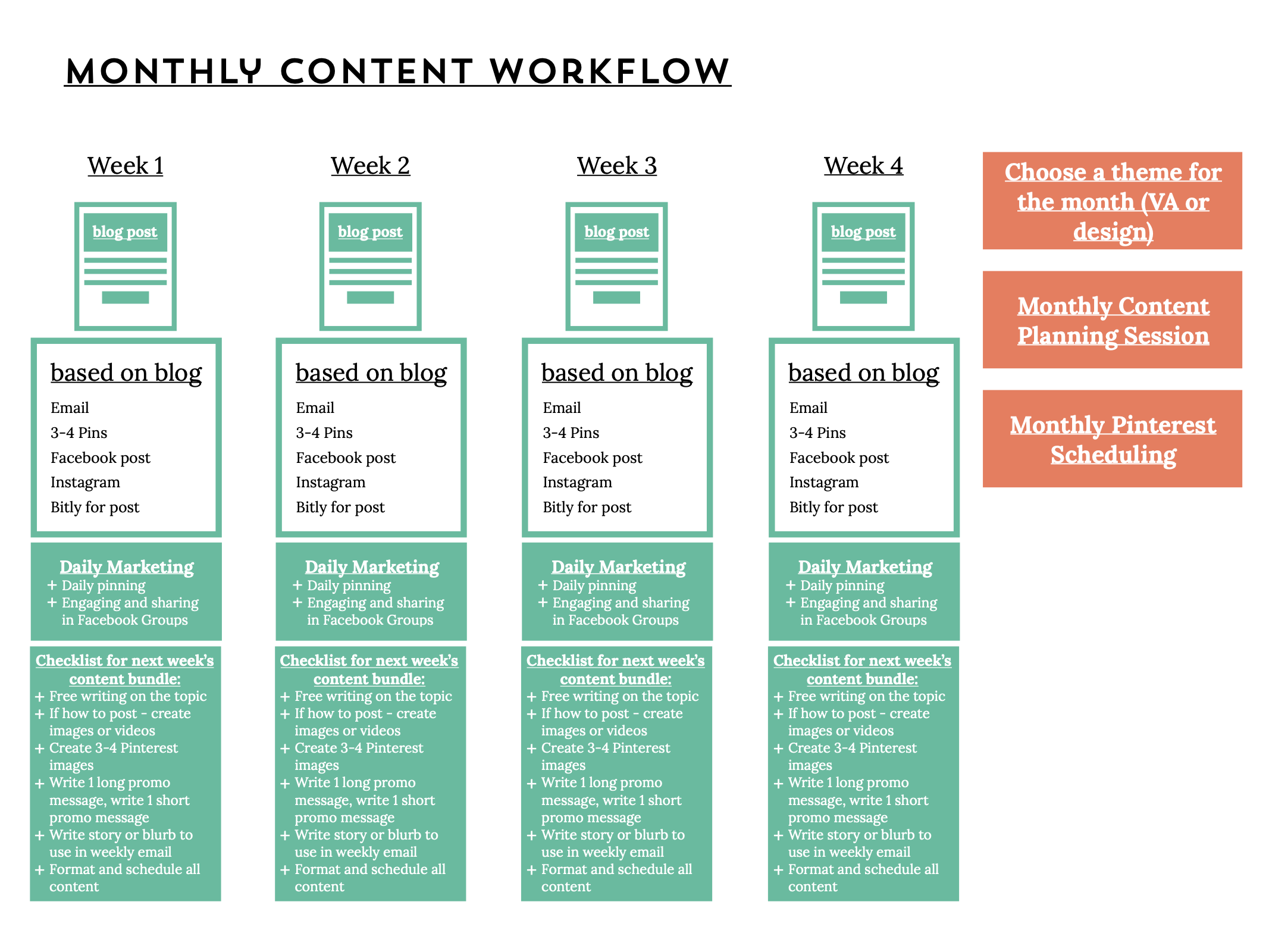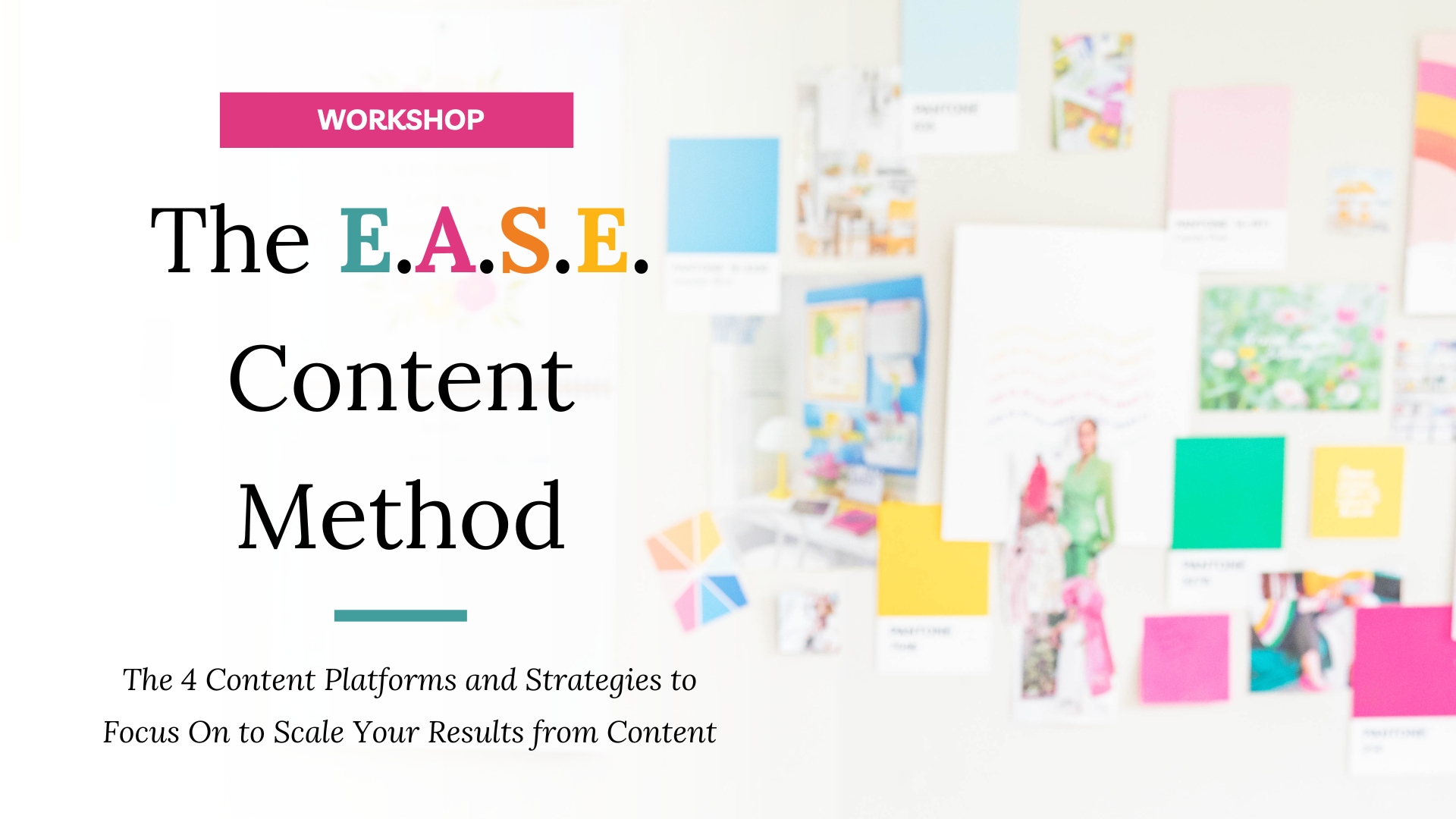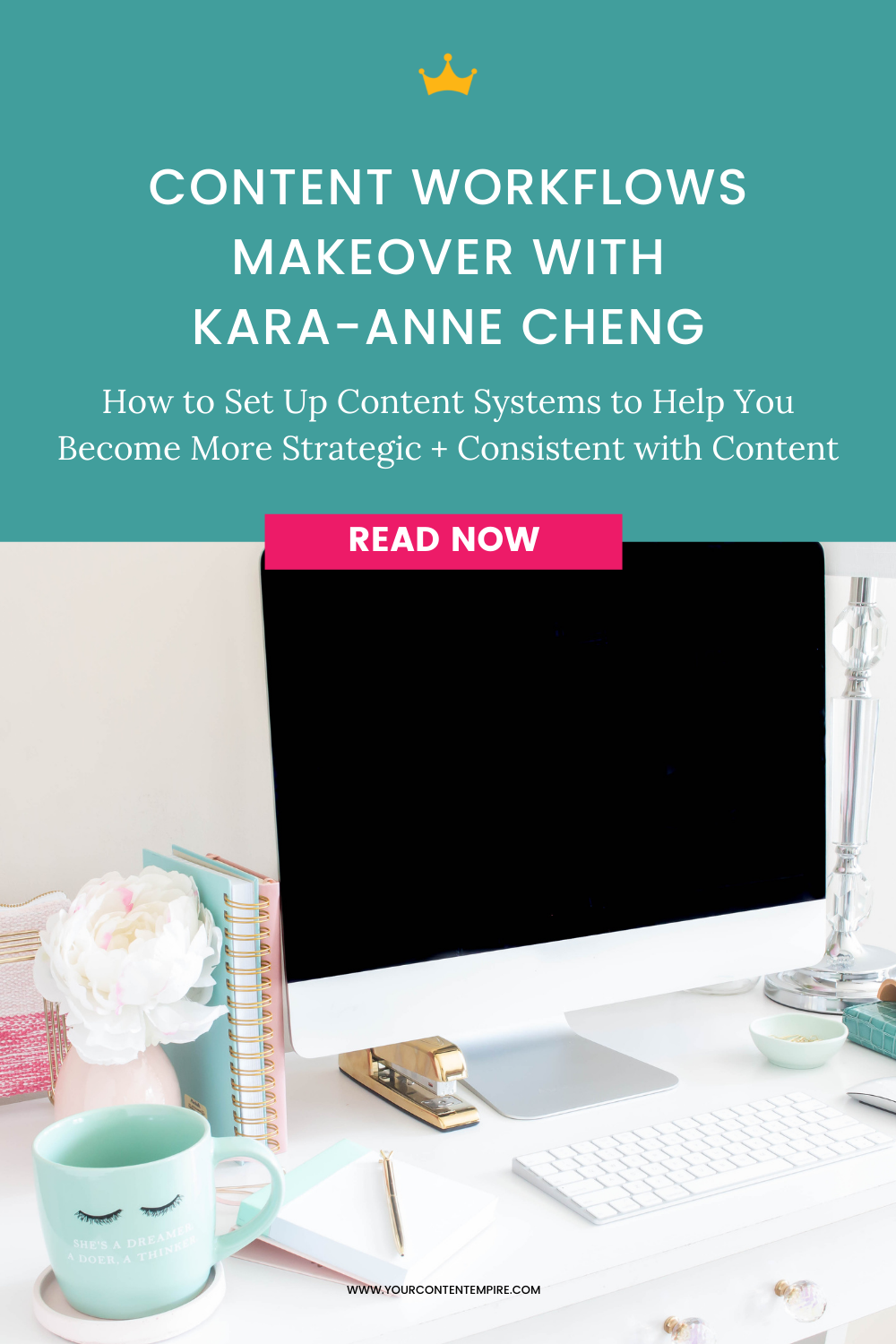This post is a part of the Content Empire Takeover series (actually it’s the first one!) Think of it like Tabatha’s Salon Takeover but for online entrepreneurs. My community has told me that they’re craving content that goes beyond a simple how-to but really goes into depth of how a content, funnel or launch strategy works for real businesses just like theirs. And to be honest, I’m craving this realness too! Thus the Content Empire Takeovers were born. So join me as I give you a full behind-the-scenes into a variety of creative businesses, their challenges and my strategic process and solutions.
I couldn’t be more excited at having had the opportunity to dive into systems and content workflows with someone whose work I respect and adore very much, Kara-Anne Cheng from The Petite Co. I loved combining my content strategy and systems with her own systems brilliance to come up with content workflows that’ll help her work reach a whole new audience and hopefully inspire you in coming up with your own too!
Meet Kara-Anne Cheng
Kara-Anne Cheng is a brand and business support strategist helping overwhelmed online business owners grow with confidence and scale their business intentionally so they can live a well-lived life. Based in Singapore with her husband and her 4 bunnies (3 fosters!), she has worked with businesses all over the world for the past 5+ years to launch purposeful brands, businesses and programs.
What she loves most about what she does?
I love that I get to support and be a part so many businesses in different, dynamic ways – from helping them gain clarity around their brand and take action on their strategies, to tangibly supporting overwhelmed business owners by creating systems and managing tasks so they can focus on what they love to do and get better results.
State of Her Content Empire and Content Workflows
What does her current content strategy look like?
I am currently transitioning from being a full-fledged branding and Squarespace designer to focusing more on the brand strategy and business support side of things, so my content strategy might be a little bit all over the place.
For my goal coaching and brand strategy program, Live Your Legacy: I have a Curated Brand email challenge and a Curated Brand cheat sheet that I'm testing for conversions. I offer a Curated Brand PDF Workbook which goes into a bit more detail about building a cohesive and timeless brand online. This should be geared more to the strategy side, as this used to funnel to my design stuff as well. I also offer a one-time discounted 45-minute brand strategy call at the end of the funnel.
For my business support service: I offer a 2-hour trial at a discounted rate as my lead magnet. I am in the midst of brainstorming and creating another lead magnet.
I am writing about branding, design and systems and organisation on my blog and email ‘newsletters' weekly. In each blog post, I have a content upgrade that helps them implement the content or gives them a perk. I also am growing my Instagram through stories, and have plans to go on weekly Instagram / Facebook Lives to talk about branding strategy and planning out systems. I haven't quite fleshed these out yet.
What does her “in a dream world” content strategy look like?
I always have a content vault of things people want to read about – I have one now based on brief research on Facebook groups but I can never know if people truly want to and will read about them. They would naturally want to sign up for my lead magnet, and I would know what to send to them every week.
What is working really well with her systems and content workflows?
I enjoy writing my blog posts a lot, though I am usually writing them on the day of publishing rather than batch creating. I take way too long on each blog post though I do draft and outline them out in advance.
I am scheduling my social media feeds and have been consistent so far (1.5 months only though), and created a welcome email sequence and content upgrades / upsells for the first time. I've scheduled them all on ConvertKit but yet to run them.
What could be working better with her systems and content workflows?
I feel like I am struggling to come up with content to fill all the places – social media, blog and emails. It just feels like a lot and that I dilute my message and end up having nothing important to say, or disappear in the midst of everyone saying similar things.
I am working on scheduling my Instagram and Facebook/LinkedIn posts every first week of the month, and I do, but most of them fall flat and I don't get much engagement.
More automation + evergreen content so I don't have to keep putting out content?
The Content Workflows Power Hour

Takeaway #1 – Managing 2 niches from a single website
One of things that’s unique about Kara-Anne’s situation is that she’s transitioning her business from legacy + design focus to also add in virtual assistance with an emphasis on tech and systems (which made getting to work with her on content workflows even more fun!).
But does that mean that she has to create an entirely new website devoted to that new service type? Not necessarily.
While I think it’s important to make is easy for her community to only get content they feel is relevant to their interests, this can be achieved a few different ways:
(1) Having category pages on the website along with a feed of all posts. So they can bookmark and navigate easily to find posts they’re interested in.
(2) Having an easy “opt-out of this category” button in email service provider that removes the category tag and excludes them from future emails about the topic.
(3) Choosing a quarterly or monthly focus for her offers and thus for the content she’ll be creating. So that even though she offers and talks about both branding and virtual assistance – she isn’t talking about both at the same time and confusing her audience. Kara-Anne’s pretty clear that she’ll be focusing on virtual assistance until the end of the year.
Takeaway #2 – Having a defined regular content bundle
Another thing that we focused on straight away is coming up with Kara-Anne’s weekly content bundle. The general content slots that are filled each week on her chosen platforms.
To do this for yourself:
- How often am I publishing a new blog post? What day of the week does that happen?
- When am I sending out regular emails?
- What am I posting about on each of my social media platforms and on what days?
Takeaway #3 – Batch or bespoke content creator?
Kara-Anne spoke of her history with bespoke content workflows – where she would just create a blog when she felt like it. But she also had begun recently experimenting with batching and loved all of the upsides it provided (less time, more efficient, got it out of the way). But she also found that batching made her exhausted and by the time she finished writing all the posts – the last thing wanted to do was proofread.
Her plan is to write weekly for the next 6 months and then once she’s built up adequate content around systems and virtual assistance to go down to biweekly publishing. Goal is to have 10 All-Star systems posts
In the end, she made the decision that she’d like to remain on a week-to-week creation schedule (just made more sense for her). So we decided to build a weekly content workflow but provide an alternative monthly batching workflow too for when she wanted to use that instead.
Takeaway #4 – Tricking Herself into Starting
Kara-Anne talked at length about the biggest struggle with content was the actual writing. Just getting started is difficult.
So one of the processes she plans on experimenting with is the free-writing process. When she adds a topic to her calendar, she’ll take 15-20 minutes to free write on the topic. Meaning that without pressure, without expectation and with a timer set, she’ll write down anything that comes to mind related to the post topic.
My free writing process is this…
- Set a timer for 15-20 minutes
- Write down the main takeaway for my reader (this is my goal for the post)
- Write down the call-to-action for the post (this is what I want them to do with it)
- Then brainstorm what questions or steps will this post follow or need to answer to accomplish the takeaway for the readers
- Spend a little time answering each of those questions
- What’s an example or story that I can use to introduce the topic
Content Phase #1 – Content Planning Phase
Ongoing: Continue tracking topic inspiration that you find in Facebook groups in a topic inspiration bank you create in your project management (Asana) as you come across them. Add in a tagging system for categorizing ideas as virtual assistance, branding or legacy. (Tool recommendation: Asana chrome extension for quickly adding ideas and links to inspiration board)
90 Minute Work Content Workflows (once a month):
- Review analytics to answer following questions:
- What posts/freebies/offers were the most popular this month?
- Where did the majority of my traffic come from?
- Where did I see growth this month (views/email list/social)?
- What should I do more of this coming month?
- What should I do less of this coming month?
- Decide on revenue goal and what offer to focus on for the month
- How many sales do you have to make to reach your revenue goal?
- How many calls or sales page views do you have to reach to meet that goal?
- Brainstorming content topics and pulling from topic inspiration bank
- What blog content will help you generate interest for your offer?
- What email content will help you generate interest for your offer? (Regular email and direct invitations)
- What social content will help you generate interest for your offer?
- Building your calendar
- Assign the topics to date slots in your editorial calendar (based on content bundle – see Takeaway #2)
- Create a google folder for each post that houses everything related to the post
- Free writing on your upcoming topics – For each upcoming post, set a timer for 10 minutes a complete free writing to get your ideas for the post outlined now so that when it’s time to write, you’ll have already done the hard part of starting
- What’s the main takeaway for my readers?
- What’s the call-to-action?
- What questions will this post answer to deliver the main takeaway for readers?
- Quickly answer each of those questions.
- Do you have content you could repurpose for this post?
- Is there a story or example that introduces this topic?
Content Phase #2 – Content Creation Phase
60 Minute Work Block (once a week):
- Open free-written outline (from planning phase) and blank Google Doc
- Write post
- Formatting
- Upload to Grammarly for proofreading (upload, edit and export to keep formatting intact)
- Upload to Hemingway App for clarity
60 Minute Work Block (if post is a how-to with tutorials or images):
- Gather images and record tutorials as needed for the post
- Export and add to Google folder for post
Content Phase #3 – Content Production Phase
60 Minute Work Block (once a week):
- Create 3-4 Pinterest images by updating templates, export and upload to post folder – Optional if post has content upgrade – Create content upgrade using template (or create a template for it if you don’t have yet for that type)
- Write 1 long promo message based on the post and 1 short promo message based on the post to use on social media
- Write 1 blurb or story to use in your email newsletter that promotes and directs people to the post
Content Phase #4 – Content Publishing Phase
30-45 Minute Work Block (once a week):
- Upload and format blog post in Squarespace and pre-schedule
- Create a bitly link for the post
- Upload and format newsletter in ConvertKit, send a test and pre-schedule
- Upload and schedule social media (Facebook page, Instagram)
60-Minute Work Block (once a month, last week of the month)
- Schedule other people’s content to each of your Pinterest non-group boards so that roughly 1 pin goes out to each board per day of the upcoming month using Tailwind
Content Phase #5 – Content Promotion Phase
Daily marketing process – 15 minutes
- Manually pin 1 blog post or freebie image to your main board (the one with just your content)
- Using Tailwind, pin that same pin to your other boards and group boards so that they go out throughout the week (8-hour interval, exact, starting same day)
- Manually copy and paste short promo message for the post in Facebook groups (keep a list of the ones you’re a part of and their promo days)
Content Phase #5 – Content Publishing Phase
30-45 Minute Work Block (once a week):
- Upload and format blog post in Squarespace and pre-schedule
- Create a bitly link for the post
- Upload and format newsletter in ConvertKit, send a test and pre-schedule
- Upload and schedule social media (Facebook page, Instagram)
Real-Time Promotion:
- Daily pinning of the blog post with alternate images as well as freebies
- Engaging in Facebook groups – posting blog posts on share threads
- Creating Facebook posts in groups and profile about topics related to the blog post and offer topics (i.e. behind-the-scenes, wins, did you know I do this… style of posts)
Ready to Implement Your Own Content Empire Takeover?
Get instant access to my E.A.S.E. Content Strategy Workshop plus get my exclusive EASE Content Planning Spreadsheet for FREE ↓ It's the perfect way to get started:









